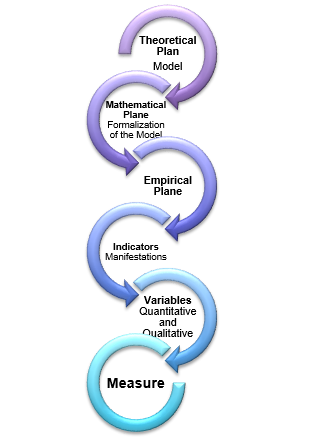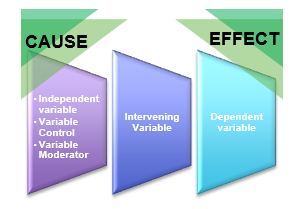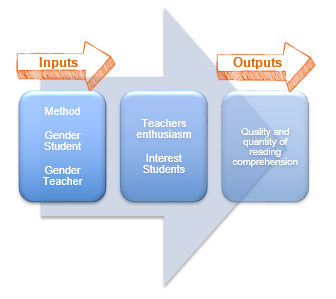A response variable is a result measured within an assay that can be influenced by other factors. For example, in a trial you can test whether a new drug is effective in reducing a certain symptom of a heart disease. In this case, the decrease of the symptom is measured and this measurement is a response variable (also called dependent variable). In contrast, the new drug is the independent variable, which is tested to determine if it has caused a change in the dependent variable.
The researcher moves between the world of theory and the world of observation. In either case it moves in the world of concepts, constructs and variables. To make his experiment operative the student must move from the abstract to the concrete. So you can understand what we are saying let’s start from the beginning.
A model like this must have a series of characteristics, such as hypothetical-deductive, that can be materialized, that represent the reality that you want to study and that is done for the purpose of study and research.
The measurement puts in relation these three planes: the theoretical, the empirical and the mathematical. Let’s explain more carefully what we just said.
For the researcher to carry out his experiment, one of the tasks he must perform is to measure the study variables with appropriate instruments. This measure suggests that the researcher starts from a model that includes a series of concepts and constructs that are somehow related and that are the expression of the conceptualization that he has of the reality he wishes to study. These concepts are abstract entities that need to be transformed into observable elements for their measurement. This transformation is done through the identification of the properties of the constructs. This identification of the empirical indicators of the objects and phenomena is what makes the researcher go from the theoretical to the empirical level.
The measurement consists, in the assignment of numbers or words to such empirical indicators, directly or indirectly observed of the objects or facts according to some rules, norms or criteria.
The variables, resulting from the process of operationalization from the theoretical to the empirical plane, are the manifestations of the constructs, and to which they can be assigned values or words that the researcher will relate or contrast.
The variables can be of two types depending on what actions or behaviors they express or imply. The measurement variables describe how it will be measured by the researcher. The experimental variable explains the details of the manipulations that the researcher will do with them.
So far we have seen some concepts that are important to know thoroughly the research of an experimental nature. Below we will go into detail to study the variables from the methodological point of view.

The relationship between the variables in an experiment responds to the model hypothesized by the researcher in his research. These variables are classified into five types: Independent, Moderator, Control, Dependent and Intervening. The first three are input or conceptualization of what happens between cause and effect and often not controlled by the researcher.

Independent Variable
It is represented by an X. It is the variable that the researcher measures, manipulates or selects to determine its relationship with the observed phenomena or phenomena. This variable is also known as the stimulus or input variable. It is a variable that may have its origin in the subject or in the environment of the subject. It is the variable that the researcher manipulates to see the effects produced in another variable. In the simplest relation, a researcher studies what would happen to the variable effect when it changes the values of the variable cause or independent variable. An example of an independent variable could be the teaching method of reading that a teacher uses to improve the reading comprehension of their students.
Dependent Variable
It is represented by a Y. The dependent variable is the factor that the researcher observes or measures to determine the effect of the independent variable or variable cause. The dependent variable is the response variable or output or output variable. In behavioral terms, this variable is the resulting behavior of an organism that has been stimulated. It is the factor that appears, disappears, varies, etc., as a consequence of the manipulation that the researcher makes of the independent variable. The dependent variable is considered so because its values will depend on the values of the independent variable. The dependent variable represents the consequence of the changes in the subject under study or in the situation that is being studied. From the previous example, the dependent variable will be the changes or improvements that students experience in their reading comprehension after a period of training.
Variable Moderator
Represented by Xm. This variable is a type of independent variable. This variable is measured, manipulated or selected to check if it modifies the relationship between the experimental independent variable and the dependent variable. The researcher gives a secondary value in the research and includes it in the study to determine how it also influences the dependent variable. If the researcher believes that in addition to the independent variable, there are other independent variables that may affect the relationship between X and Y, then it is when he introduces this or these other independent moderator variables into his study. Following the previous example, the independent moderator variable could be the gender of the participants. The teacher may be interested in knowing if the method gives better results with the students or with the students
Variable Control
Represented by Xc. This variable is the one that the researcher controls in order to eliminate or neutralize its effects on the dependent variable. The difference between the moderator variable and the control variable is that the moderator variable is included in the study to see its effects on the dependent variable and the control variable is neutralized to eliminate its possible effects. The reason for this categorization of control variables is that not all the variables in an experiment can be studied. The way to eliminate their effects or not to include them in the study is to control them in a natural or antifial way. For example, if the researcher suspects that the gender of the teachers who teach with reading methods can influence the improvement of the students’ reading compensation, the way to eliminate this possible effect is to control it, that is, making all the teachers who participate are of the same gender.
Intervening variable
Represented by Xi. The intervening variables are those that theoretically affect the dependent variable but can not be measured or manipulated. Normally they are variables that are deduced from the effects of the variables: independent and moderator, on the dependent variable. This type of variables has a sometimes unspecific character, hence they can not be included in any of the categorizations made previously. The difficulty with this type of variability is that being present are difficult to identify and measure by the researcher. Hence, they are sometimes defined at the conceptual level. For example, the enthusiasm put by teachers in the use of the method of reading, the interest of the students, etc.
At the schematic level, the set of all the variables could be represented as illustrated below:

